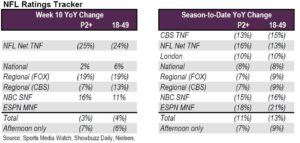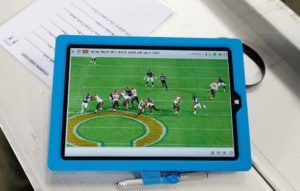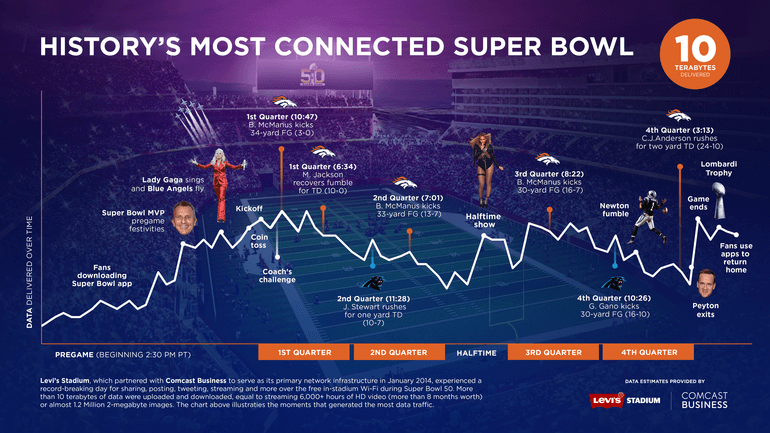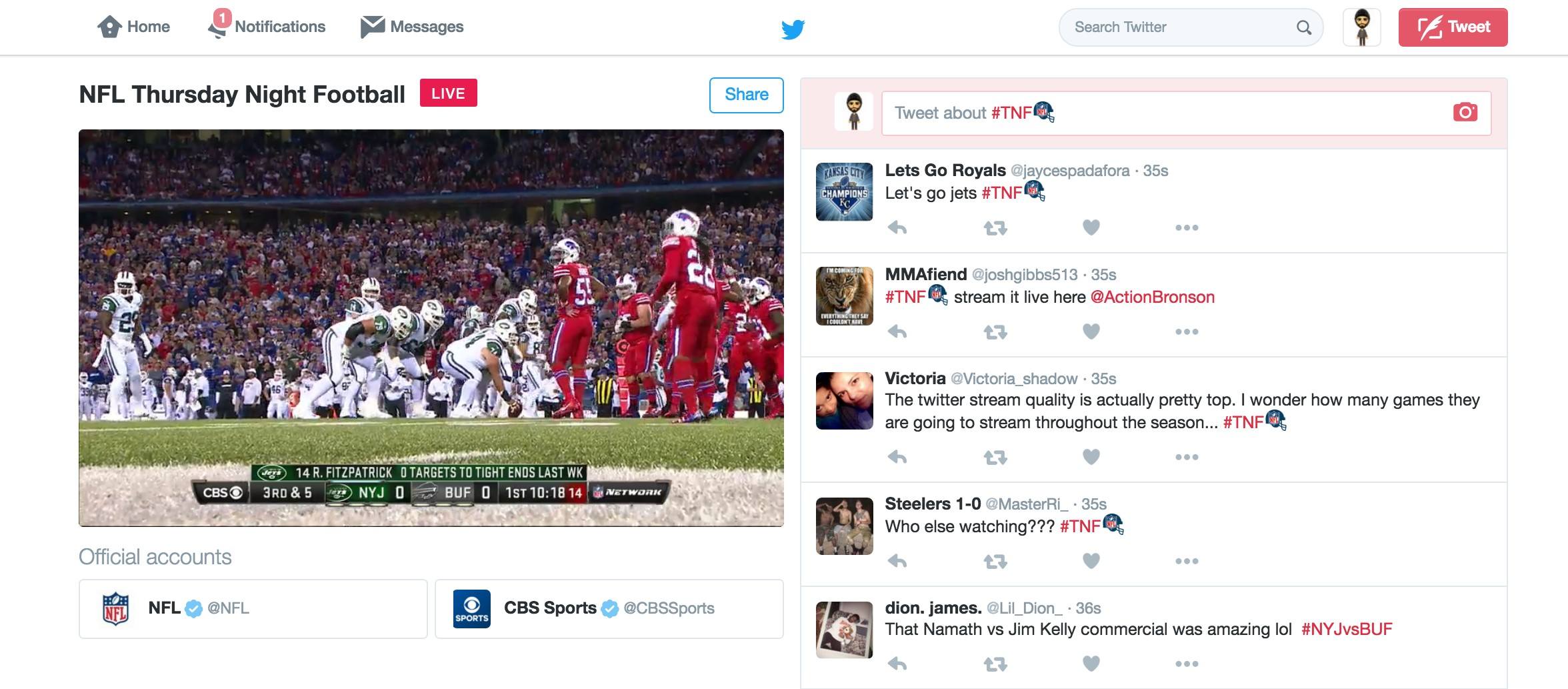ARE YOU READY FOR SOME FOOTBALL!?!? – The NFL’s Fight to Evolve in the Digital Age

“We respect our traditions, but we embrace evolution.” – Michelle McKenna-Doyle, NFL Chief Information Officer
While other sports leagues and live entertainment competitors rushed to leverage the rapid growth of the internet and digital media revolution into their core business models, the National Football League (“NFL”) rested on its traditional positioning as the leader in live entertainment, consumed by its viewers through in-person ticket sales and television broadcasts. Although the NFL grew revenue to $12.2 billion in 2015 (Ozanian, 2016), the league’s inability to embrace digitalization has appeared to negatively impact its business model with television ratings down 11% year-over-year through week 10 of the 2016 season (Brown, 2016). Despite the NFL’s slow digital integration and recent negative business trends, the league has implemented several key initiatives in its business strategy and operating model to try to catch-up to the wave of digital trends.

Gameplay
For decades, the core gameplay of the NFL remained consistent – quarterbacks received play calls from coaches via hand-signals or direct communication; coaches would review handwritten or printed copies of plays or defensive coverages with players on the sideline; and there was little-to-no ability to track the metrics of how a player was performing on the field. In 1994, the league first approved helmet radio technology between a coach and quarterback to speed up gameplay, and in 2012 made additional strides in this technology by switching headset signals from analog to digital, which improved sound quality and reduced interference (National Football League, 2016). The NFL even expanded wireless headsets to referees in 2014 to allow for more effective communication between officials before plays and to discuss penalties more quickly (National Football League, 2016).
In addition to implementing digital technology into headsets, the league made a huge change to gameplay operations by implementing the use of Microsoft Surface tablets in 2014 (National Football League, 2016). The tablets allow coaches and players to review digital images of plays and formations on the sideline, which enhances the strategic competitiveness of teams during gameplay and provides an enhanced viewing experience for consumers.

Viewing Experience
Despite the positive impact of digital technology on NFL gameplay, the impact of digital on the in-person and television / media viewing experience is the most difficult challenge facing the NFL’s long-term strategy today. Although initially believed to be driven by an increase in millennial fans, the NFL recognized that a decline in game attendance was driven by all fans’ desire for enhanced connectivity and accessibility during games (Maddox, 2016). Therefore, the NFL implemented an initiative to install wi-fi in every stadium across the league in 2014 – today, only three stadiums do not have wi-fi (Maddox, 2016). The importance of wi-fi was displayed on the NFL’s biggest stage when over 10.1 terabytes of data were transferred over the wi-fi at the newly opened Levi’s Stadium during Super Bowl 50 in February 2016. This data usage marked a 63% increase over Super Bowl 49 and was the highest data usage ever seen at a single sports and entertainment event (Maddox, Super Bowl 50 smashes data records with 10.1TB flying across Wi-Fi, 2016).

In addition to needing to address the in-person viewing experience at stadiums, the NFL has had to address a shift in viewers consuming games from traditional paid-television formats to alternative forms of media. To address this shift, the NFL has launched several digital media initiatives. In 2015, Yahoo! became the first website to livestream in NFL game (Dave, 2015), and in 2016, the league pushed into social media by launching a partnership with Twitter to stream ten Thursday night games and becoming the first sports team to have a presence on Snapchat’s Discover page (Arora, 2016). The NFL has also focused on revamping its NFL mobile app through its exclusive partnership with Verizon (Elberse, 2010).

Continued Innovation
Although the NFL may have been late to the digital revolution, the league has clearly taken significant strides in adapting its gameplay and viewing experience as part of its overall business and operating models. Nevertheless, there are still several key initiatives that the league should implement to ensure its success going forward:
- Gameplay – Continue to take strides to improve the on-field product for fans by utilizing advances in technology to increase the competitiveness of the games while improving the safety of the leagues greatest asset: the players
- Stadium Viewing – Use new mobile technology to enhance the in-game experience and engage fans directly in their seats. Implement best in-class mobile stadium enhancements such as in-seat concessions ordering and restroom tracking across all venues
- Television / Media Viewing – Focus on monetizing consumers at the point-of-consumption. Accept the fact that traditional viewing formats are evolving and the NFL must evolve with it while finding new ways to engage viewers (787 words)
Works Cited
Arora, S. (2016, September 7). Technology Meets the Real World – NFL Goes Digital. Retrieved from MarTech Advisor: http://www.martechadvisor.com/articles/ads/technologymeetstherealworldnflgoesdigital/
Brown, M. (2016, November 15). Here’s the Real Reasons NFL TV Ratings Will Continue Downward. Retrieved from Forbes.com: http://www.forbes.com/sites/maurybrown/2016/11/15/herestherealreasonswhynfltvratingswillcontinuedownward/
Dave, P. (2015, September 4). NFL putting its online playbook to the test. Retrieved from latimes.com: http://www.latimes.com/business/la-fi-nfl-digital-20150904-story.html
Elberse, A. C. (2010). The NFL’s Digital Media Strategy. Boston: Harvard Business School.
Maddox, T. (2016). How the NFL and its stadiums became leaders in Wi-Fi, monetizing apps, and customer experience. Retrieved from TechRepublic: http://www.techrepublic.com/article/how-the-nfl-and-its-stadiums-became-leaders-in-wi-fi-monetizing-apps-and-customer-experience/
Maddox, T. (2016, February 10). Super Bowl 50 smashes data records with 10.1TB flying across Wi-Fi. Retrieved from TechRepublic: http://www.techrepublic.com/article/super-bowl-50-smashes-data-records-with-10-1tb-flying-across-wifi/
National Football League. (2016). Technology. Retrieved from NFL.com: http://operations.nfl.com/the-game/technology/
Ozanian, M. (2016, September 14). The NFL’s Most Valuable Teams 2016. Retrieved from Forbes: http://www.forbes.com/sites/mikeozanian/2016/09/14/thenflsmostvaluableteams2016



Zach, it’s interesting to hear that the NFL’s ratings are down this year. Sports have been growing successfully for so many years that I would not have expected that. Other entertainment options do prevent a unique challenge for the NFL and all other sports organizations. There are more entertainment alternatives to sports then there have ever been (ex. Netflix, Video games, Youtube, etc.). The competitors to sports keep getting improved entertainment that is more and more exciting and realistic while Sports are offering essentially the same product they were offering 40 years ago. It will be interesting to see if Sports leagues find a way to improve their entertainment value through digitization or if other entertainment sources take market share from sports as their products improve.
I think while you do address several ways the NFL has attempted to address digital issues with its business model, I don’t believe that it has to do with the decline in ratings. I think there are several key reasons causing the decline which don’t have to do with technology. These include the increase in concussions and how the league has attempted to change rules to reduce the risk of concussions, penalties around celebrations which were much more entertaining years ago, oversaturation by introducing games on Thursdays, the way the league has handled off the field controversies (Ray Rice, Josh Brown, Ezekial Elliot, Deflategate… etc) and simply just significant competition from other television content (the presidential election, new shows… etc)
In the last ten years, the average NFL ticket price has increased from $62 – $93 per game. Do you think the drop in interest could be due to the rising costs without consumers believing they are getting increased value? Is the NFL doing anything to use automation or digital technology to try and lower costs in order to attract more consumers? I am also glad to see that you addressed them needing to take additional steps to protect their players – it’s disappointing that they haven’t done more.
https://www.statista.com/statistics/193425/average-ticket-price-in-the-nfl-since-2006/
Great topic Zack! Its pretty interesting to me that the NFL chose Twitter as its partner to live stream games online. I agree that live streaming online is a necessity in today’s digital world (especially considering that practically every game can already be found online illegally), but I think it was a relatively poor decision to partner with a social media platform that has been under such negative scrutiny over the last few years and appears to be on its way out. I think by altering their method of delivering live online streaming there is certainly some room for improvement for the NFL.
Great post on an interesting topic, Zach. I’ve also seen many of the headlines this year about the decline in NFL TV ratings and have been trying to understand why. There are two potential reasons I’ve come across. Some analysts have said that the introduction of more London-based games (which typically start around 9:30 am ET) has alienated some fans and drawn criticism. From what I have read, its being attributed to the fact that the NFL is now trying to own all of Sunday, not just afternoon and evening, and fans simply cannot commit to 12-14 hours of football viewing. The other possibility, which I find true in my own experience, is the growth in popularity of NFL RedZone. I find that the only games I watch anymore are the ones of my team, and the rest of the time I just watch RedZone – which has no commercials and therefore is much more difficult to monetize due to the lack of ad revenue. Sometimes I wonder if I’d actually enjoy going back to the pre-RedZone days more.
Thanks Zack, so far, from a consumer perspective, I’ve been pretty underwhelmed by the NFL’s mobile app and how they’ve thought about capturing value from “connecting with connected fans”, so I’m glad to hear they are investing more here for the future. That being said, it seems like their biggest challenge is figuring out how to increase the quality of their content as they continue to increase the number of days per week and the weeks per season that NFL teams are playing. I mean, a Jaguars/Browns game on a Thursday night is not going to capture a huge audience, regardless of how the league plans to evolve their TV viewing experience.
Great post Zack. Especially given my interest in the NFL, it is interesting to hear about the different initiatives they are undertaking to better adapt to the new digital age. Similar to your experience I have been underwhelmed with the NFL’s recent moves into digital. I do think that their inability to connect with the consumer is all different mediums is causing the drop in viewership. While I get there maybe other factors, I think that the consumers are moving away from just watching their favorite team on TV and the NFL needs to do more to connect with the consumer elsewhere through twitter, snapchat, etc.
I also think that the stadium experience itself is causing part of the decline. Not only is it very expensive to get tickets but the view from the majority of the seats are not great for viewing the game.
It seems that the NFL has many issues that it is facing. It’s good to see that they are addressing some of the key issues such as viewing experience as well as climate change. It seems that attending games is becoming less appealing because the viewing experience at home is so enjoyable. That is something that the NFL needs to balance. However, they may target to maximize TV and online viewing because it is more profitable. There are several other factors that are contributing to why NFL ratings are suspected to be declining including, election year, concussions / health issues, stories of domestic abuse, on-field protests, on-field celebrations, and improvements from other forms of entertainment.
Thanks for the post, Zack, it was a great read and interesting topic. One other aspect of the game that comes to mind is the technological advancements in the play review process. It seems like this is one area that has seen a lot of improvement over the years, and the league continues to work towards achieving the slimmest margin of error as possible. I’d be interested to see how this system continues to improve in the future.